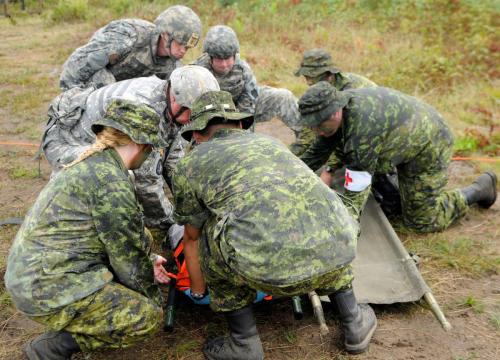Canada: Pennsylvania Army Guard medics cross-train with Canadian Army during exercise Steadfast Warrior
Medics from the Pennsylvania Army National Guard’s 2nd Battalion, 112th Infantry Regiment and Canadian Army medics trained together as part of exercise Steadfast Warrior, something both groups found invaluable.

Medics from Headquarters and Headquarters Company, 2nd Battalion, 112th Infantry Regiment, Pennsylvania Army National Guard, work with Canadian Army medics to transfer a simulated casualty onto a stretcher during a medical cross-training as part of exercise Steadfast Warrior at Canadian Forces Base Petawawa, Ontario.
“I think this type of training is priceless,” said Army 1st Lt. Daniel Clark, medical platoon leader and field medical assistant for the medical platoon of Headquarters and Headquarters Company, 2nd Bn., 112th Inf. Regt. “Being able to work with other countries and other medics from different units, you cannot get that anywhere else.”
The joint training scenario involved a Canadian casualty reported by forces in the field as if a real-world incident.
“It was an exercise scenario where we get a call, called a nine-liner,” said Canadian Army Capt. Jennifer Purdy, a medical officer with the Canadian Army’s 2nd Field Ambulance. “Basically it gives us the information about an accident that has occurred or injuries that have occurred, and we had a person come in with a fictitious femur fracture. Basically, we had to stabilize and or treat as necessary.”
Spc. Dylan Casner, was one of the combat medics with HHC, 2nd Bn.,112th Inf. Regt. participated in the scenario.
“I was the recorder,” he said. “We have a team (that carries the patient): one guy is on head, one guy on the upper body and one guy on the lower body. And that is exactly how they set up.”
Once the casualty arrived at the aid station, the team went to work checking for other injuries and vitals such as breathing and pulse, he said.
“One person began yelling out vitals, others were yelling out where the injuries are, yelling out the conditions and all that,” said Casner. “And then whoever gave out morphine yelled that out, and I wrote it down,” he said. “So, that’s exactly how we would do it.”
There were other similarities in the way the two teams worked together, such as treating casualties as close to the battlefield as possible.
“The idea behind the Canadian medical system is that we try to treat them at various stages as close to the battlefield as possible,” said Purdy. “But, if we have to send them back (to their unit or on for higher-level care) we try to stabilize them as best as possible, and that is what we did with the situation here,” said Purdy.
The wounded service member was then prepared for transportation and moved to an ambulance that had arrived in support of the scenario. The loading onto the ambulance marked the end of the scenario, but the importance of cross-training with multi-national forces was not lost on the soldiers involved.
“I think that involving the U.S. with our training is very important because when we go overseas we are working hand in hand,” said Canadian Army Cpl. John Stewart, a medical technician with the 2nd Fld. Amb.“In Afghanistan there are a lot of times when the hospitals are manned by both Americans and Canadian troops, so it’s good that we get some more training now for future operations.”
Stewart, who along with Purdy has trained with U.S. forces prior to this event, stressed the learning both forces receive in cross-training and performance.
“This is not my first time working with the Americans, and I always found that I learn something new,” said Stewart. “And, I think that it is important to switch things up and learn from a different perspective to learn new ways and for the Americans to learn new ways.”
This is also a different sort of training event for the Pennsylvania Soldiers.
“We are part of the headquarters [company] and the headquarters are there to support the line companies,” said Clark. “All of our medics get pushed out to the field and pushed out to the line companies. So it’s really hard for us to say, ‘Oh well, during the live-fire you cannot get medics because we need to train this kind of stuff.’
But, those times when the medics are training with the line companies are important because the Soldiers need to learn to trust those medics who might save their lives one day, he said. But, the chance to train and learn between the Canadians and Americans at Petawawa is immeasurable.
“Overseas we are a coalition force or a multi-national force,” said Clark. “This time we learned how to work out all the kinks. We learned their different ways to practice stuff, and they learned our ways of practicing stuff. How we go about doing things and they go about doing things.”
That makes for a more fluid operation when it’s a real-world mission.
“When you go overseas and it is the first time working with Canadian forces or British forces or something, those kind of seconds that it takes you to think, ‘well, that is not how I do it or that is how I do it or that is the same thing,’ are precious seconds that in the medical sense are what really count,” said Clark.
Source: U.S. National Guard
- 349 reads




